INFOGRAPHIC: Healthy piglets after weaning



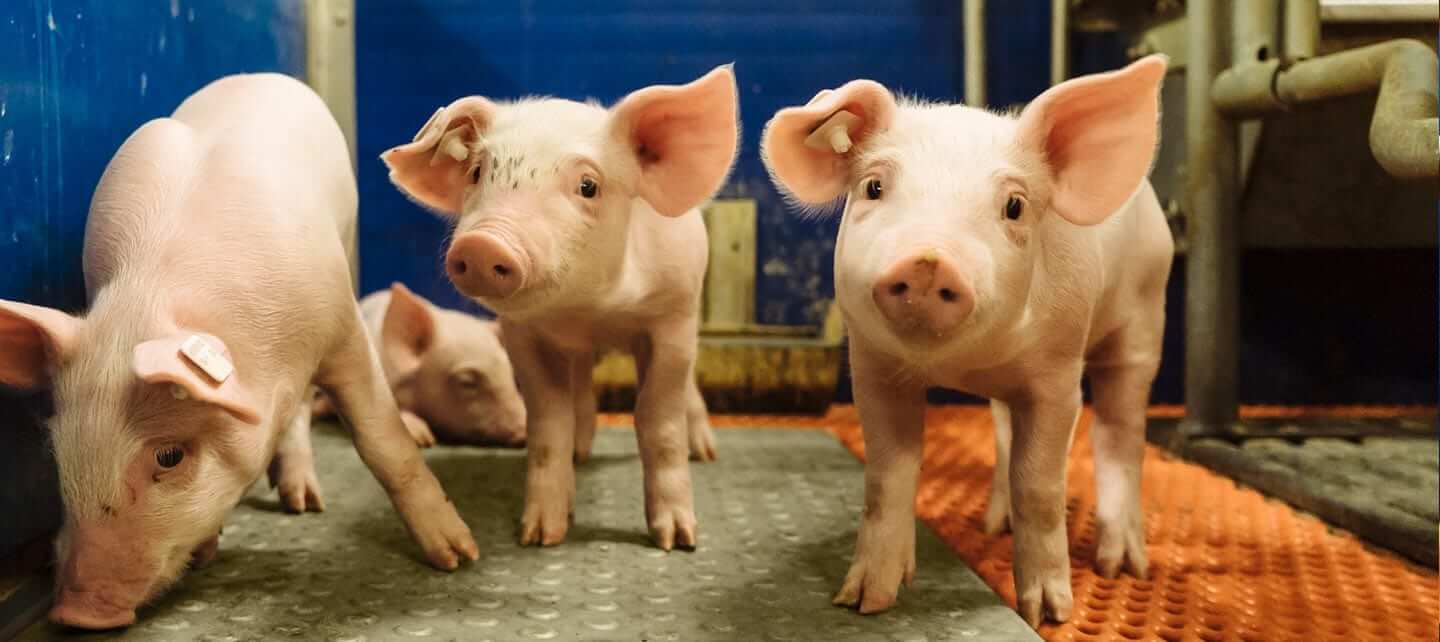

In contrast to humans, piglets do not receive any maternal immunoglobulins via the placenta. It is therefore of vital importance for these young animals to receive maternal antibodies via the colostrum as soon as possible after birth. Otherwise, they are more vulnerable to illnesses in their early stages of life.
In this article, we look in-depth at how the immune system works and which role antibodies play in it. We then consider why egg proteins might potentially be a powerful tool for supporting young animals immunologically, allowing producers to maintain young animals’ health and to promote their performance.
The immune system aims to prevent pathogens such as viruses, bacteria, and fungi from entering the body or to eliminate them when they have already entered. Furthermore, it seeks to prepare the body for quicker reactions, in case of subsequent infections, by building an immunological memory. Generally, in case of an attack by pathogens, there are three barriers against the “enemy” (Figure 1).
Figure 1: The three barriers of the immune response
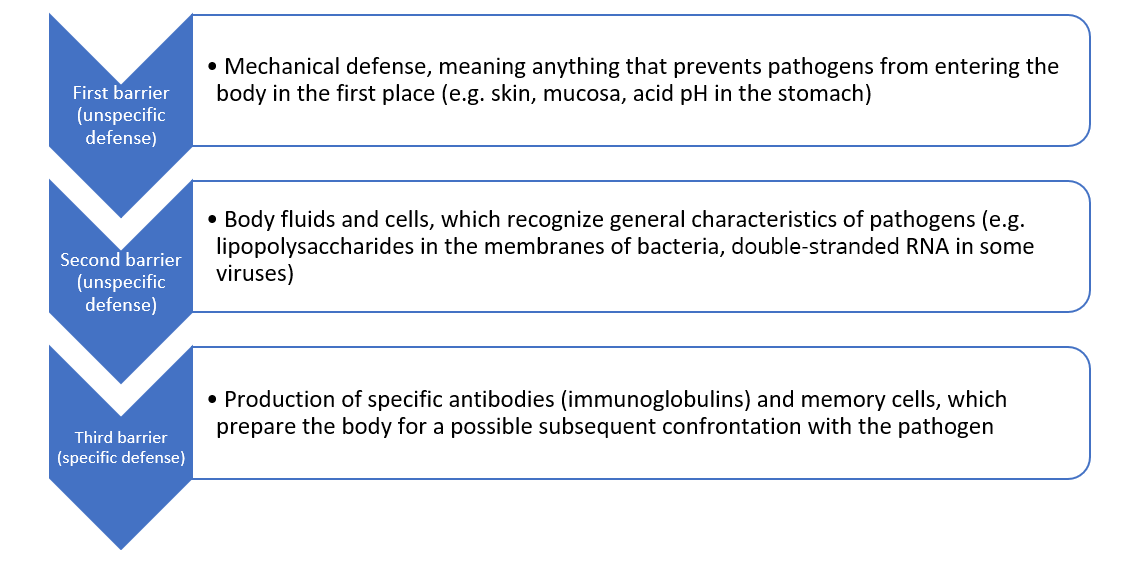
First barrier: the immediate, physical defense upon contact with pathogens
The animal body has several anatomical features that prevent pathogens from entering in the first place, such as cilia and mucus. Skin, intestines and nose lining are colonized by a community of beneficial micro-organisms that form a physical barrier against pathogens. Other barriers include the urinary system, the acid pH of the stomach, as well as tears and saliva, which contain antibacterial lysozymes.
Second barrier: the unspecific, native defense that does most of the work
If the mechanical mechanisms of defense were not successful, the unspecific, innate immune defense enters into play (Murphy and Weaver, 2018, 47ff.). At this stage, the body needs to differentiate between “known” and “alien” agents, and between “potentially harmful” and “harmless” ones.
To identify alien, potentially harmful agents, the unspecific defense looks for so-called PAMPs (pathogen associated molecular patterns). These are general characteristics often displayed by pathogens, such as lipopolysaccharides in the bacterial membrane or double-stranded RNA in viruses. Everything that shows PAMPs is heavily targeted.
The unspecific defense can be further divided into the humoral and the cellular defense. The humoral defense consists of substances dissolved in the body fluids, such as enzymes, reactive oxygen compounds, signal molecules and a whole cascade of proteins. Some of these substances kill pathogens directly; others “mark” the pathogens and “call for” the help of leucocytes.
The cellular defense consists of different leucocytes, also known as white blood cells (because they do not contain any red hemoglobin). The main task of leucocytes is the defense of the body against pathogens, hence many leucocytes are capable of phagocytosis (the ingestion of other cells). To prevent phagocytes from accidentally ingesting the body’s own cells, these own cells are marked with the so-called major histocompatibility complex (MHC). This acts as a red flag, saying “I belong to the body!”.
The cellular defense consists of:
Figure 1: The three barriers of the immune response

The monocytes, as well as their macrophage and dendritic cell “offspring”, are the bridge to the next step, the specific defense. When these phagocytes digest pathogens, minuscule protein structures (antigens) of the pathogens remain. These antigens are unique to each pathogen. During a process called antigen presentation, the antigens are tied to the cell’s MHC and transported to the cell surface. This triggers the production of specific antibodies, the immune system’s third barrier.
Third barrier: the specific immune defense that creates antibodies and immunological memory
The specific (also called adaptive or acquired) immune response kicks in a few days after contact with specific pathogens and is mostly carried out by lymphocytes called T and B cells (Murphy and Weaver, 2018, 177ff.). They are active at the cellular and the humoral level, respectively.
T cells possess receptors on their surface through which they can recognize the antigens presented to them by phagocytes. What they do subsequently depends on the subtype of the T cell:
B cells also possess receptors through which they can recognize antigens. Once they spot an antigen (and T helper cells “confirm” that an immune response is required), they divide and mature into so-called plasma cells. Plasma cells, in turn, secrete plenty of antibodies (or immunoglobulins) into the bloodstream and the lymphatic system. Antibodies are protein structures that lock onto and neutralize antigens through different mechanisms.
The chemical reaction between antibodies and antigens is the body’s most powerful immune response through which it can protect itself from pathogens and their toxins. Antibody production continues for several days to remove the antigens, and antibodies usually remain in circulation for a few months.
Moreover, certain T and B cells memorize the first attack of a pathogen and turn into memory cells. The T memory cells CD4+CD8+, for instance, match the antigens from certain past, latent, and particularly persistent viral infections. This immunological memory, created by acquired immunity, can be thought of as a library of antibodies that the body adds to whenever it deals with a new pathogen or receives a vaccine. In case of a subsequent contact with the pathogen, the right antibody “model” already exists and mass production can start up very quickly.
Building one’s immunological memory takes time. A lot of new-born animals are in a vulnerable position: they have not had time yet to acquire immunity of their own, but they are also particularly fragile and susceptible to being attacked by commonly occurring pathogens such as corona and rotaviruses, E. coli and clostridia. The toxins that E. coli and clostridia, for instance, release, may cause diarrhea, edema, endotoxic shock, and even death.
To be protected during the first critical days of their lives, new-born animals thus need to receive a foundational stock of antibodies (passive immunity) from their mother. Humans receive maternal immunoglobulins via the placenta. Piglets, because a sow’s placenta is constructed differently, are dependent on receiving them through the colostrum after birth. If this is not the case – due to inadequate quantity or quality of the colostrum – they need to receive immune support in a different way.
Egg-yolk antibodies have been proposed as a powerful tool for supporting young animals during the critical period after birth. These special proteins support the colostrum supply and guarantee that every animal in the herd has some degree of protection. This protection mostly takes place in the gut. The IgY recognize and tie up pathogens and render them ineffective.
In 2009, research at the National Veterinary Research Institute in Pulawy, Poland, was conducted to probe this hypothesis. The objective of the trial was to evaluate whether an oral application of egg proteins would have a quantifiable, positive influence on the immune system of the piglets. Different immunological parameters were measured, including different types of leucocytes.
Trial design
The test consists of 6 litters with 67 piglets in total divided into two groups. The control group (n=32) received the prophylaxis customary on the farm; the trial group (n=35) additionally received a product based on egg powder (EP)[1], applied at the inclusion rate recommended by the producer. Blood samples were taken on days 0 (before application of the product), 7, 14, and 28. They were analyzed with respect to the percentages of different types of lymphocytes.
Trial results
For the group receiving egg powder, the number of leucocytes in peripheral blood was significantly elevated compared to the control group on the 7th day of life (table 1). The amounts of lymphocytes and monocytes – indicators for the specific immunological defense – were also significantly increased on day 7, whereas the total amount of granulocytes – indicator for the innate, unspecific immune defense – remained constant. Hence, already during the first days, the piglets supplied with EP disposed of a higher level of adaptive (specific) immune defense, compared to the animals in the control group. In addition, there was a significant increase in the number of CD4-positive (CD4+) and CD4-CD8-double positive (CD4+CD8+) T cells in the EP group, compared to the control animals, indicating an active stimulation of the immune system.
Except for CD4+CD8+ T cells (which remained elevated in the EP group), on day 14, the differences in cellular immune response were no longer significant. This is most probably the case because by that time the immune system of the control group had activated its own protective response. The EP product therefore supported the young animals precisely when it was necessary, during the critical first days of life.
Table 1: Hematological parameters measured in piglets after prophylactic application of an egg powder based product (EP1)
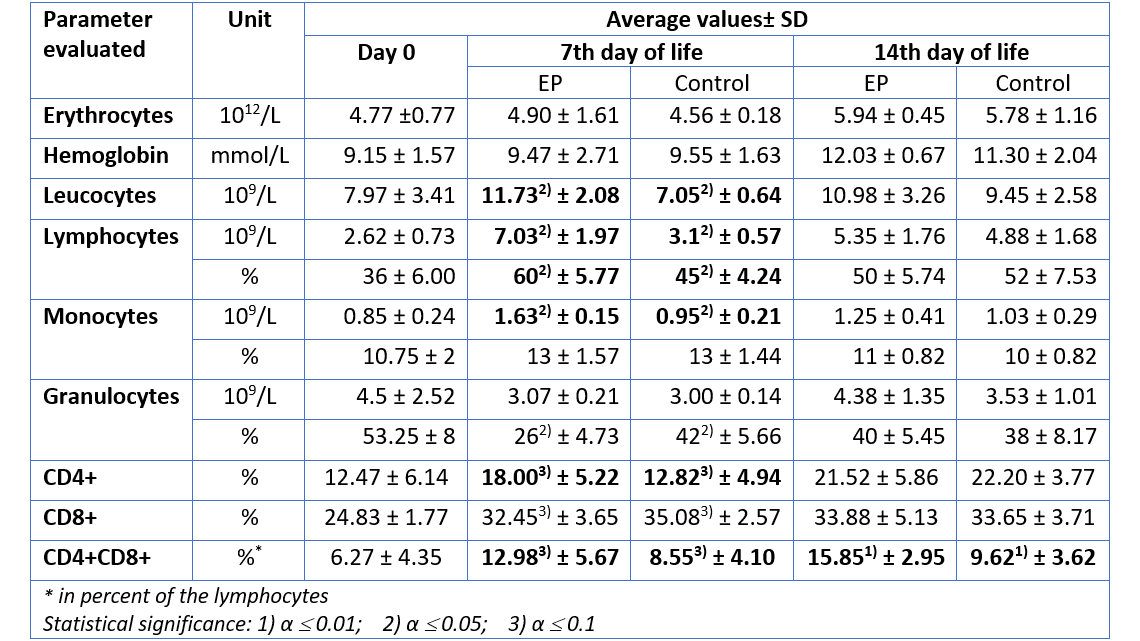
1Ig-PRO P (EW Nutrition)
The improvement of immune status, as indicated by the presence of the specific immune cells, was confirmed by the results for the incidence of diarrhea and mortality (table 2). The animals of the control group showed a nearly 1.5 times higher incidence of diarrhea and a 1.6 times higher rate of mortality. Another explanation of these results could be the mode of action of egg immunoglobulins: by neutralizing the pathogens directly in the gut, they prevent them from causing diarrhea in the first place.
Table 2: Incidence of diarrhea and mortality

In conclusion, this trial demonstrates that natural egg proteins effectively support the immune system of piglets during the critical period of the first days of life.
Thanks to the stimulation of the young animals’ specific immune defense and the direct neutralization of pathogens in the gut, the incidence of diarrhea – one of the main causes of losses during the first weeks of life – decreases. Hence, mind the immunity gap: providing piglets with a suitable egg powder based product sets them up for long-term health, growth, and performance.
By I. Heinzl and S. Regragui Mazili
Foley, J. A., and D. E. Otterby. “Availability, Storage, Treatment, Composition, and Feeding Value of Surplus Colostrum: A Review 1, 2.” Journal of Dairy Science 61, no. 8, 1033-1060. doi.org/10.3168/jds.S0022-0302(78)83686-8.
Heinzl, Inge, and Fellipe Barbosa. “Egg Antibody Technology for Nursery Pig Application.” Swineweb.com. June 24, 2019. Accessed July 17, 2019. http://www.swineweb.com/egg-antibody-technology-for-nursery-pig-application/.
Marquardt, Ronald R., L. Z. Jin, Jung-Woo Kim, Lin Fang, Andrew A. Frohlich, and Samuel K. Baidoo. “Passive Protective Effect of Egg-yolk Antibodies against Enterotoxigenic Escherichia Coli K88 Infection in Neonatal and Early-weaned Piglets.” FEMS Immunology and Medical Microbiology 23, no. 4 (1999): 283-288. https://doi.org/10.1111/j.1574-695X.1999.tb01249.x.
Murphy, Kenneth M., and Casey Weaver. 2018. Janeway Immunologie. 9th ed. Translated by Lothar Seidler. Berlin: Springer.
Nascimbeni, Michelina, Eui-Cheol Shin, Luis Chiriboga, David E. Kleiner, and Barbara Rehermann. “Peripheral CD4 CD8 T Cells Are Differentiated Effector Memory Cells with Antiviral Functions.” Blood 104, no. 2 (2004): 478-486. doi:10.1182/blood-2003-12-4395.
Yokoyama, Hideaki, Robert C. Peralta, Roger Diaz, Sadako Sendo, Yutaka Ikemori, and Yoshikatsu Kodama. “Passive Protective Effect of Chicken Egg Yolk Immunoglobulins.” Infection and Immunity 60, no. 3 (March 1992): 998-1007. https://iai.asm.org/content/iai/60/3/998.full.pdf.
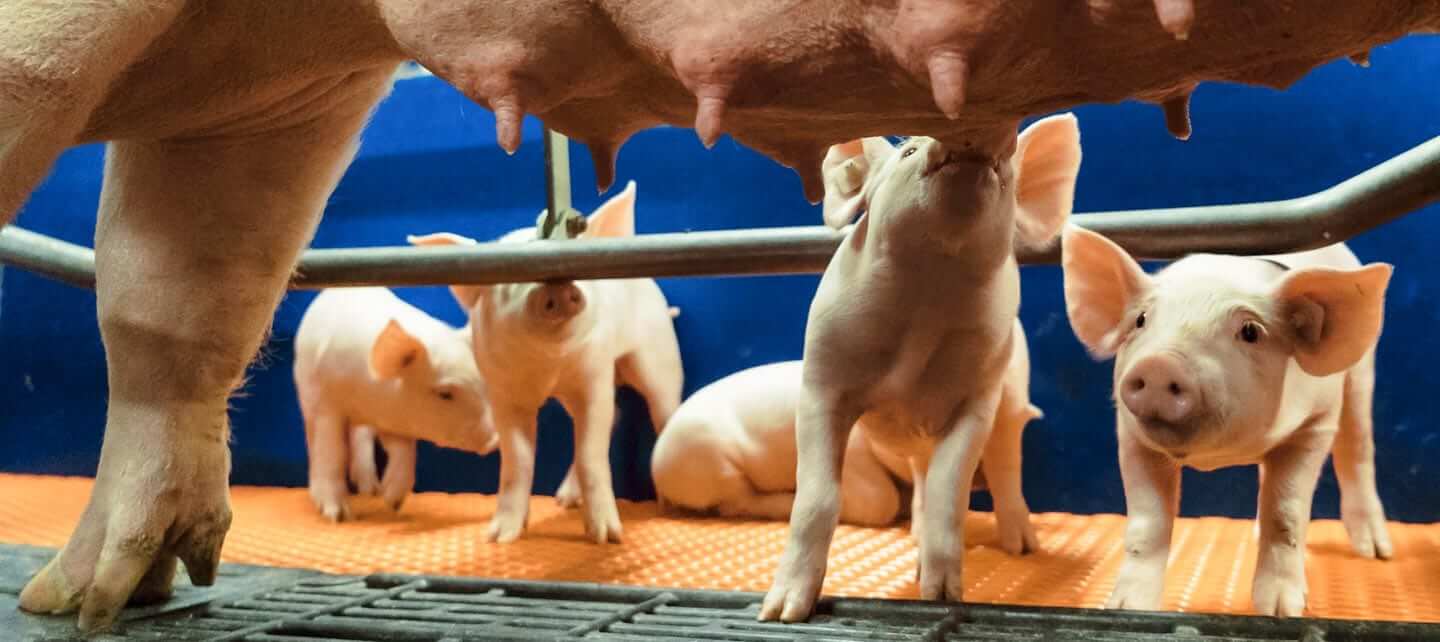

The most important parameters for a pig producer are the number of healthy pigs weaned/sow/year and their weaning weight. Due to improved genetics, it is possible today to find production systems that deliver more than 30 pigs weaned/sow/year. Strategies to increase sow productivity need to take into account the management, feeding, and health of both the piglets and the sows.
It is generally known that pigs are born physiologically immature. Their energy reserves are limited. They only possess 1-2 % fat, the main part of which is subcutaneous or structural fat protecting organs, joints and skin. Thus, the young pigs depend on the glucose of the glycogen deposits in the liver as main source of energy. This energy supply only meets their requirements for the first few hours.
Besides that, pigs cannot count on maternal antibodies. Unlike in humans, a sow’s placenta is not built to enable the transfer of these protective cells within the womb. At birth, the amount of protective cells in a pig’s intestine, the main site of pathogenic contamination, is therefore virtually zero. As they are born without any immune protection, new-born pigs rely on an early supply of antibodies from the maternal colostrum. During the first 24-36 hours after birth, antibodies are absorbed in the intestine and pass directly to the bloodstream. The intestinal barrier then closes. Importantly, the content of antibodies in the colostrum decreases with every hour after birth.
Given this difficult situation in the early stages of life, it is clear that the farrowing unit should be as comfortable as possible for the young animals:
Cleaning both the farrowing unit and also the sows/gilts before placing them is helpful. Producers, however, have to understand that a sow is continuously shedding pathogens through her feces and that her young come into contact with them. In fact, sow manure is the first source of contamination for new-born pigs.
There are several methods to decrease pathogens within the sow’s gut. Feeding them natural substances such as probiotics or phytomolecules (also known as secondary plant compounds) in order to improve gut health is one possibility: beneficial microbes such as lactobacilli or bifidobacteria compete with pathogens such as E. coli or clostridia for nutrients and prevent their proliferation. Phytomolecules such as carvacrol and cinnamaldehyde, on the other hand, were found to have antimicrobial properties.
Could feeding them natural egg proteins be another possibility?
Yokoyama et al. (1992 and 1997) already showed that natural egg proteins applied to piglets bind to pathogens within their intestinal tract. If they also bind pathogens in the sow’s gut – generating harmless complexes – this could be the key to reduce pathogenic pressure in the farrowing unit.
Method
To evaluate this possibility a trial was conducted in Japan. Two groups of eight sows were used. The sows of the control group received standard lactation feed. The trial group was also fed standard feed, but additionally received a supplement containing egg powder product (EPP) at a dosage of 5g/sow twice daily during the last ten days before and the first seven days after delivery. The feces of the sows were obtained by rectal stimulation (in order to rule out contamination from the environment) on day 10 before and day 7 after delivery. The amount of colony-forming units (CFU) of total E. coli, E. coli O141 and Clostridium perfringens was determined.
Results
The results are shown in figure 1. At the beginning of the trial, before the application of the EPP, both groups showed nearly the same level of the pathogens evaluated, with a slight disadvantage for the EPP group. After 17 days of using the EPP, the sows of the EPP group showed lower levels of pathogens in their excrements than the sows of the control group. A reduction in the colony-forming units of total Escherichia coli (from 107.12 to 106.3), Escherichia coli O141 (from 106.8 to 105.6) and of Clostridium perfringens (from 105.17 to 104.24) could be seen.
*The product used in this trial was Globimax® Sow, EW Nutrition.
It is important for pig producers to understand how they can combat adverse influences on their animals’ performance. The results of this trial showed that supplementing the standard sows’ diets with the EPP substantially reduced the amount of pathogenic colonies in sow’s manure. Reducing pathogenic pressure in the farrowing unit is central to reducing the incidence of diarrhea and pre-weaning mortality. Giving young pigs the best possible start in life sets them up for delivering the best possible performance – and more healthy and heavy pigs weaned/sow/year means a more profitable farm.
Figure 1: Amounts of total E. coli, O 141 E. coli and Clostridium perfringens in the feces of sows 10 days before delivery (before the first application of EPP) and 7 days after delivery (after the last application of EPP)
By Inge Heinzl and Fellipe Barbosa
Yokoyama, H., Peralta, R. C., Diaz, R., Sendo, S., Ikemori, Y. and Kodama, Y. (1992): Passive protective effect of chicken egg yolk immunoglobulins against experimental enterotoxigenic Escherichia coli infection in neonatal piglets. Infection and Immunity, March edition, 998-1007.
Yokoyama, H., Hashi, T., Umeda, K., Icatlo, F. C., Kuroki, M., Ikemori, Y. and Kodama, Y. (1997): Reduced intestinal colonization with F18-positive enterotoxigenic Escherichia coli in weaned pigs fed chicken egg antibody against the fimbriae. FEMS Immunology and Medical Microbiology (18), 153-161.
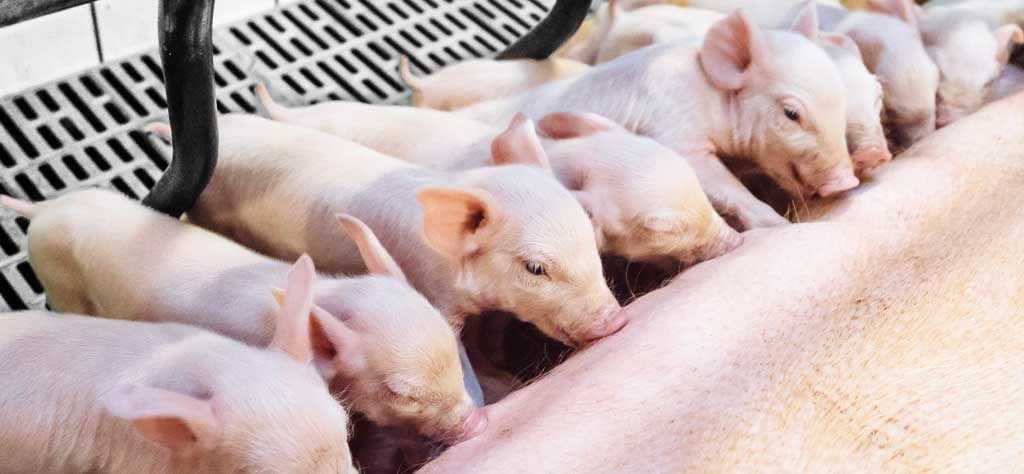
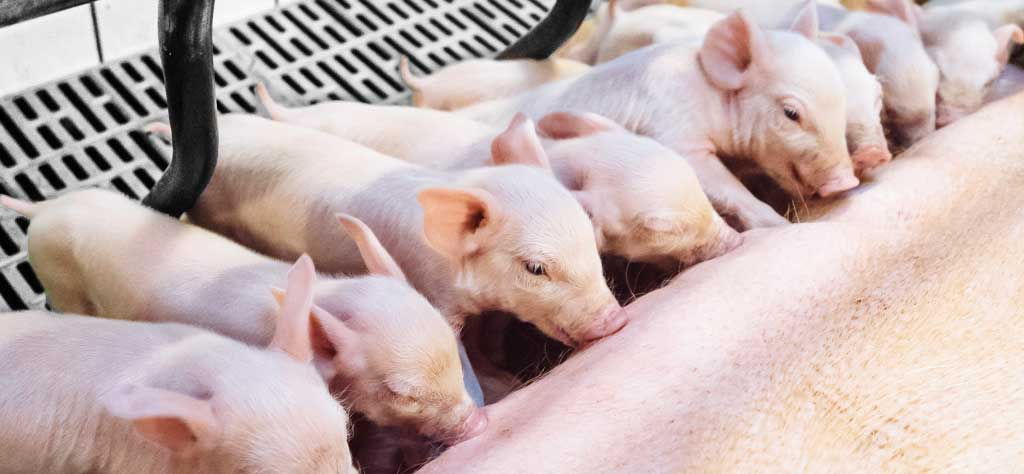
For newborn pigs there are often a host of different challenges – think of crushing or contamination of the farrowing pen.
For the last problem, solutions exist. A dietary approach can help to relieve pathogenic pressure through sow manure.
The main objective of a piglet producer is to maximise the number of healthy weaned piglets per animal per year. Nowadays, it is not difficult to find production systems delivering more than 30 piglets weaned/sow/year. Combining strategies on management, feeding, and health of both piglets and sows, is crucial for increasing sow’s productivity. A unique environment that can determine the success of a piglet farm is the farrowing unit. It is important to reduce as much as possible losses during this period. Pre-weaning mortality must always be monitored and targets must be set. In European conditions, it ranges between 8-10%.
One important driver in reducing pre-weaning mortality is understanding the fragility of newborn piglets. At birth, the resources of a piglet are very scarce: low energy reserves and practically no immune defence against existing pathogens in their new environment. Problems are prone to happen and will be mostly caused by pathogens present in the environment, in the feed, in the water and most important, in the faeces of the sow. The main contamination source for newborn piglets is their mother’s manure. And this first contamination can be quite severe causing diarrhoea and increasing piglet mortality.
Together with crushing, diarrhoea definitely causes a high percentage of total losses during the first days of life. In most of the cases, the disease is caused not only by one agent but by a combination of enteric infections from different pathogens or at least different strains of a pathogenic species. E. coli and clostridia are two of the most important diarrhoea causing pathogens during the first weeks after birth.
Pathogens during the first days
E. coli is well known as one of the main responsible pathogens for pre-weaning diarrhoea. And although it belongs to the normal intestinal flora of pigs, part of the different E. coli strains are pathogenic. E. coli cause about 80% of diarrhoeas in piglets and 50% of losses in piglet production. The factors making E. coli pathogenic, the so-called virulence factors include e.g. fimbria to attach to the intestinal wall and the capacity to produce toxins.
The Clostridium species are another important pathogen class. During the suckling phase, piglets are quite susceptible to Clostridium perfringens type C. This bacteria causes necrotic enteritis in piglets and the clinical symptoms appear during the first days of life. This disease provokes serious disturbances in the organism with a mortality up to 100%. It causes significant decrease in daily gain and in weaning weight.
Strategy to protect the piglets
In order to maximise the sow’s performance – measured in piglets weaned per year – it is crucial to provide the best possible conditions to the piglets. Therefore the reduction of the pathogenic pressure in the farrowing unit ranks first. Cleaning of the pen is a way to get rid of germs like E. coli and Clostridium species, the most important pathogens during the first days. This should be completed by an effective gut health management in sow and piglets. For this purpose natural ingredients can be used. Supplying natural and active immune cells, the so called antibodies, has been proven to be quite efficient in supporting gut health. Applied to piglets, immunoglobulins from the egg bind to pathogens within the intestinal tract. They show efficiency in supporting piglets’ performance, decreasing the incidence of diarrhoea, mortality and increasing daily gain.
The idea was to check if these immunoglobulins from the egg could also bind pathogens in the sow’s gut and generate harmless complexes. That way pathogenic pressure for the piglets could be reduced. Thus a trial was conducted in Japan to check this thesis.

Trial
In the trial two groups contained eight sows each. The sows of the control group received standard lactation feed, the trial group was also fed standard feed with a supplement containing egg immunoglobulins (Globigen Sow, EW Nutrition, at a dosage of 5 g/sow twice daily) on top during the last ten days before and the first seven days after delivery. The faeces of the sows were obtained by rectal stimulation (in order to get no contamination from the environment) on day 10 before and day 7 after delivery. The amount of colony forming units (CFU) of total E. coli, E. coli O141 and Clostridium perfringens were determined.
Results are shown in Figure 1. At the beginning of the trial, before the application of the immunoglobulin supplement, both groups showed nearly the same level of the evaluated pathogens with a slight disadvantage for the supplement group. After 17 days of applying the product based on egg immunoglobulins, a reduction of the colony forming units of total E. coli, E. coli O141 and of Clostridium perfringens could be seen. The sows of the supplement-fed group showed a lower level of pathogens in their excrements than the sows of the control group.
Conclusion
It is important for swine producers to understand what adversely influences the results on the farm. One consideration is to improve farrowing unit conditions of the piglets, aiming to reduce pre-weaning mortality. The results of the trial showed that a supplement based on egg immunoglobulins supplied on top of standard sow diets substantially reduced the amount of pathogenic colonies in sow manure. The reduction on pathogenic pressure and therefore the incidence of diarrhoea may be an alternative for increasing the profitability of piglet producers by increasing the number of healthier piglets weaned/sow/year.
*References are available on request.
By Dr Inge Heinzl.
Published on PigProgress | 20th July, 2018.

The number of healthy piglets weaned is the most important factor for the calculation of profit in piglet production.
Losses in the farrowing unit normally occur during the first seven days of life as piglets are born with very little protection in the form of immunity. The intake of immunoglobulins from colostrum is therefore of vital importance. Besides cleanliness and special feeding, piglets can be additionally supported by two strategies that mimick the effect of colostrum:
– a direct one, meaning the feeding of immunoglobulins (IgY from eggs) to piglets that would support the immune system in the gut or
– an indirect one, meaning a supply of IgY to the sow to keep the pathogenic pressure in the farrowing unit as low as possible.
Piglets are born with no immune protection and very low energy reserves
It is well known that piglets are physiologically immature at birth. Their energy reserves are very low with only 1 – 2% body fat comprising mainly of structural and subcutaneous fat. Therefore, in the first hours of life they rely on the glucose supply from glycogen from the liver as their main energy source. However, this will only cover their needs for a few hours.
Due to the construction of the sow’s placenta, a transfer of immunoglobulins (antibodies) within the uterus is not possible. This means that piglets are born with practically no immune protection and depend on the immediate intake of immunoglobulins from colostrum. The immunoglobulins can be absorbed in the gastrointestinal tract and immediately transferred into the bloodstream – but also only for a short time. The absorption ability of the piglets starts to decrease soon after birth and ends after 24 to 36 hours.
Strategy 1: Making the farrowing unit as safe as possible
The piglets’ environment should be warm to prevent hypoglycaemia. Piglets looking for heat close to the sow can also get crushed. Since the temperature needs of the sow and piglets are different, a piglet nest with a special heat lamp is recommended. Furthermore, the farrowing unit should be clean. Due to their low immune status, piglets are susceptible to common pathogens such as E. coli, Clostridium perfringens, and rotavirus that can all lead to diarrhoea.
Most pathogens can be traced to those found in the sow’s faeces. To keep this amount as low as possible, different measures can be taken:
– A vaccination increases the immune defences of the sow. The antibodies fight against the pathogens so that less “functioning” pathogens are excreted.
– Feeding of probiotics increases the number of good bacteria like Lactobacilli and Bifidobacteria competing with the pathogens for binding sites and nutrients.
– Administration of egg immunoglobulins, which bind to the pathogens within the gastrointestinal tract and make them harmless. These pathogen-immunoglobulin-complexes can be ingested by the piglets without any danger.
Strategy 2: Supporting the piglets with immunoglobulins
The aim here is to strengthen the local immunity in the gastrointestinal tract by increasing the amount of immunoglobulins (Ig). As already mentioned, the intake of sow colostrum is of vital importance. With the vaccination of the sow, the content of antibodies in the colostrum can even be enhanced.
An additional measure would be to orally supply the piglets with egg immunoglobulins (IgY). Both classes of immunoglobulins (IgG from mammals, and IgY from birds) can bind to pathogens in the gut, preventing them from binding to the intestinal wall and reducing the incidence of diarrhoea. The difference is in the degree of effectiveness and specificity.
Conclusion
To maximize the number of piglets weaned, it is necessary to support their immune system during the first days of life. Besides good hygiene management, the administration of egg antibodies to the sow will also help reduce the amount of shed pathogens keeping the pathogenic pressure low. The application of egg antibodies directly to the piglets supports their immune system by binding the pathogens in the gut, minimizing the risk of diarrhoea.